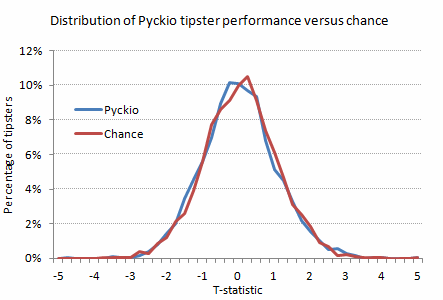How Many Football Bettors are Sharp?
Posted 15th May 2018
Note: this version of the article (17th May) is a slightly re-edited version of the original posted 2 days ago. Thanks goes to Matthew Trenhaile, former odds compiler for IG Index, for drawing attention to my terrible mathematical skills. I had made an error in the way I was comparing the size of odds movements to the strength of the margin.
It was way back in December 2013 that I first investigated how many bettors might be capable of making a long term profit, what we might call sharp bettors or 'winners'. It was a very rudimentary investigation that considered betting to operate much like the sports it focuses on: a winner takes all market. At the time I suggested a figure of 10% as a maximum for the proportion of bettors who were sharp, although it was likely to be less than 1%. This was followed by an article in March 2015 that posed the question: is sports betting completely random. I attempted to answer this by plotting the distributions of performance of several thousand betting tipsters operating at the Pyckio tipster platform and seeing what it looked like. It looked very much like a normal distribution. Whenever you see one of those, you can be fairly confident that most of what you are looking at has arisen by chance. I've reproduced the chart again below. You can also find all of this material in my last book Squares & Sharps..... This does not prove that there are no sharp tipsters at Pyckio, just that they must be relatively few in number and hard to spot against the noise of good and bad luck.

More recently I've started talking about comparing the odds you bet to the odds available at market closing, the idea being that the closing line represents the most accurate (or efficient) price (after taking account of the bookmaker's margin), at least at sharp bookmakers like Pinnacle Sportsbook who respect the significance of efficient market principles when managing customers and their betting experiences. My article for them in July 2016 showed that their closing prices provided a very reliable measure of your profit expectation. Consistently bet on teams with odds of 2.10 and see those odds shorten to 2.00 by the time the match starts and you should be confident that you've found an edge of 5% (before taking into account the margin). Last summer I provided an analysis of a set of horse racing wagers where it was possible to compare the odds bet against the Betfair starting price. It further confirmed the efficiency of a starting (or closing) price.
Christian Baier runs the betting blog BettingIsCool. It's a wonderful resource of useful things to know if you have aspirations of become a successful bettor. Recently, Christian has begun comparing the closing prices to bet prices of Pyckio tipsters, as a means of determining expected profit expectation. Remember, bet price divided by closing price (minus margin) should be roughly equal to profit expectation. Aggregated over many bets it should provide a reasonable measure of expected long term yield. Last month he tweeted a chart revealing the strong correlation between expected yield (or profit over turnover) and actual yield from a sample of approaching 100,000 wagers. I'm sure Christian won't mind me reproducing his chart.

At the time I asked Christian how many of the tipsters were beating the closing line by more than Pinnacle's margin for those wagers. It was 3% (for those tipsters with more than 50 wagers in their records). How many beat the closing line by the margin +5%? None. There was just one who beat the line by the margin +2%, although the tipster's wager sample size was relatively small. The rest were below 2%. That is to say, with one exception none of this sample of tipsters held an expected yield greater than 2%. More food for thought.
This brings me to the purpose of the latest article. Pinnacle makes no secret of the fact that they use sharp bettors to help them adjust their betting lines. Other bookmakers will not tolerate winning bettors since they cannot be accommodated in their business model that seeks to offer great value (sometime loss-leading value) and a huge variety of sports betting markets. In contrast, Pinnacle actively welcomes winners, thereby improving price efficiency, increasing betting turnover and reducing margins. If sharp bettors shorten odds, then we could formulate a hypothesis:
the proportion of odds movements which exhibit a shortening greater than Pinnacle's margin provides a measure of the proportion of wagers placed at Pinnacle that are sharp, where we define sharp as holding a profit expectation greater than 0%.
To test this hypothesis I've analysed the match betting odds movements for 100 football matches recorded at the Odds Comparison Oddsportal. There were a total of 1,203 odds movements. I should say now that my sample probably contains a number of biases. Firstly, because Oddsportal only record published odds to 2 decimal places I chose to restrict myself to looking at the higher priced teams for all matches. For short prices, Pinnacle quote to 3 decimal places. Without that information we cannot be sure of the exact change. 1.08 to 1.07, for example, is a change of 0.93% (as an odds ratio). But it could have been 1.077 to 1.073, a change of just 0.37%. For long prices Pinnacle generally quote to 2 decimals anyway, and even where they quote to 3 places, the magnitude of this error will be much smaller. Whilst it might well introduce a bias into the sample, if we assume that a price movement on one team is typically matched by an opposite movement on the opposing team, we should be OK. (Of course there is the draw to worry about in football but I'm conveniently forgetting about that for now.)
Secondly, because Oddsportal only record about the last 20 movements before closing in addition to the opening, I had to restrict myself to matches with no more. Where there are more, the opening price is then not followed by the odds after the first movement. In doing so, we are then restricting odds movement analysis to only those matches with the fewest movements and least bettor interest. Consequently this meant restricting match selection to smaller football leagues. On the plus side, however, by doing so, we are potentially targeting more inefficient markets where there is more opportunity for pricing errors to arise and be exploited. Thus we might argue that such a bias could lead to an overestimation of the true figure for the proportion of sharp odds movements.
All those caveats aside, let's get on to the results. The chart below shows the distribution of all the odds movements. Positive values imply shortening odds, negative ones lengthening odds. Accounting for the relatively small sample size, it has a very normal looking quality about it. Indeed, it is very similar to the distribution of expected Pyckio tipster yields published by Christian. The average movement for this sample was -0.15%, as near to 0% as makes no difference. Indeed, given that Pinnacle gradually reduces its margin for a football match betting market between opening and closing, thereby very slightly increasing the average odds, this result should not be unexpected.

Pinnacle's margin for these football betting markets is typically in the region of 2 to 3% depending on the liquidity of the football league. However, we have to account for the favourite-longshot bias present in football match betting markets. I've previously talked at length about the reasons why this is the case, and provided a fair odds calculator which offers three possible solutions for removing the margin which contains such a bias. Its influence means that longer odds in a book are typically found to contain a disproportionate share of the overall book margin. For example, a book with odds 2, 3.25 and 4.5 might imply fair odds of 2.04, 3.36 and 4.70 (using the logarithm function method for removing a margin.) Whilst the overround for this book is about 3%, the specific margins applied to home, draw and away are 2.01%, 3.44% and 4.41% respectively. Consequently, me must compare the size of the odds movement to the estimated specific margin for those odds. Since my sample was heavily weighted towards longer odds for the reason given above, the margins to which we will be comparing the odds movements will typically be larger than 2 to 3%. In fact the average was about 4.8% and median 3.9%.
So how many of the 1,203 odds movements recorded in the sample exhibited a shortening greater than the specific margin for those odds? In fact it was just 77 or 6.4%. Of those, there were just 15 (or 1.2%) which shortened by an amount of more than 5% greater than the margin. If our hypothesis is correct, this implies that only a small proportion of shortening odds would appear to be driven by sharp bettors.
Of course, it should be said that odds move for all sorts of reasons, not just sharp bettors showing up at the market place. There may be a general drift in prices due to random influence or possibly some pumping and pumping more prevalent at the exchanges. Additionally, large single price movements might arise as a consequence of Pinnacle themselves responding to sudden and significant news about one of the teams. Furthermore, over bigger samples of matches and odds movements we would reasonably expect there to be more sharp odds movements than sharp bettors because sharp bettors will be responsible for more than one sharp odds movement. Consequently, the proportion of single-move price shortening greater than the odds-specific margin should be seen as a maximum figure for the percentage of sharp bettors. Arguably for reasons given it is likely to be less, probably a lot less, than 6.4%. Given that the odds movements in general are fairly well normally distributed, that provides a strong case for saying that most of what happens to the price of a football team over time is random. Since news about teams should be arriving randomly at the market place, this observation is hardly surprising.
P.S. if any reader has access to a better data set of odds movements than the one I have used here, feel free to get in touch.
|





